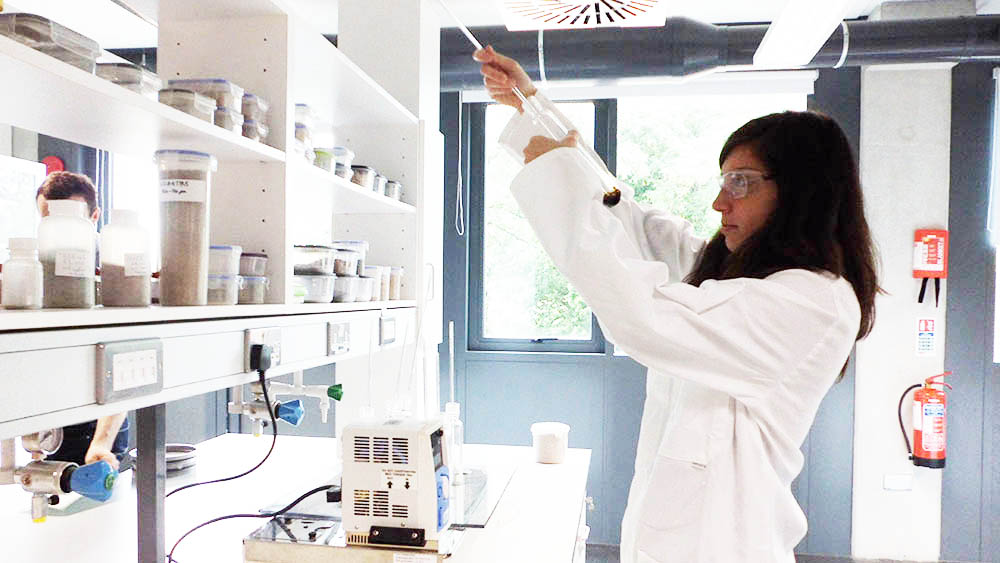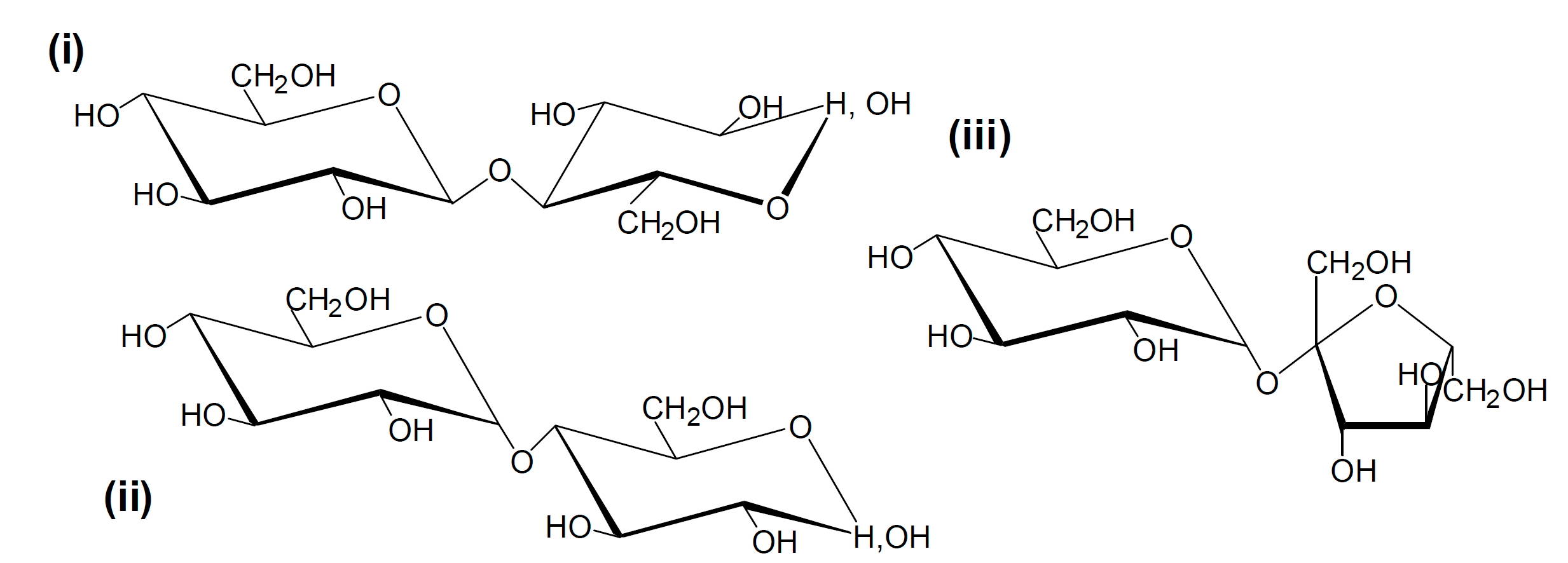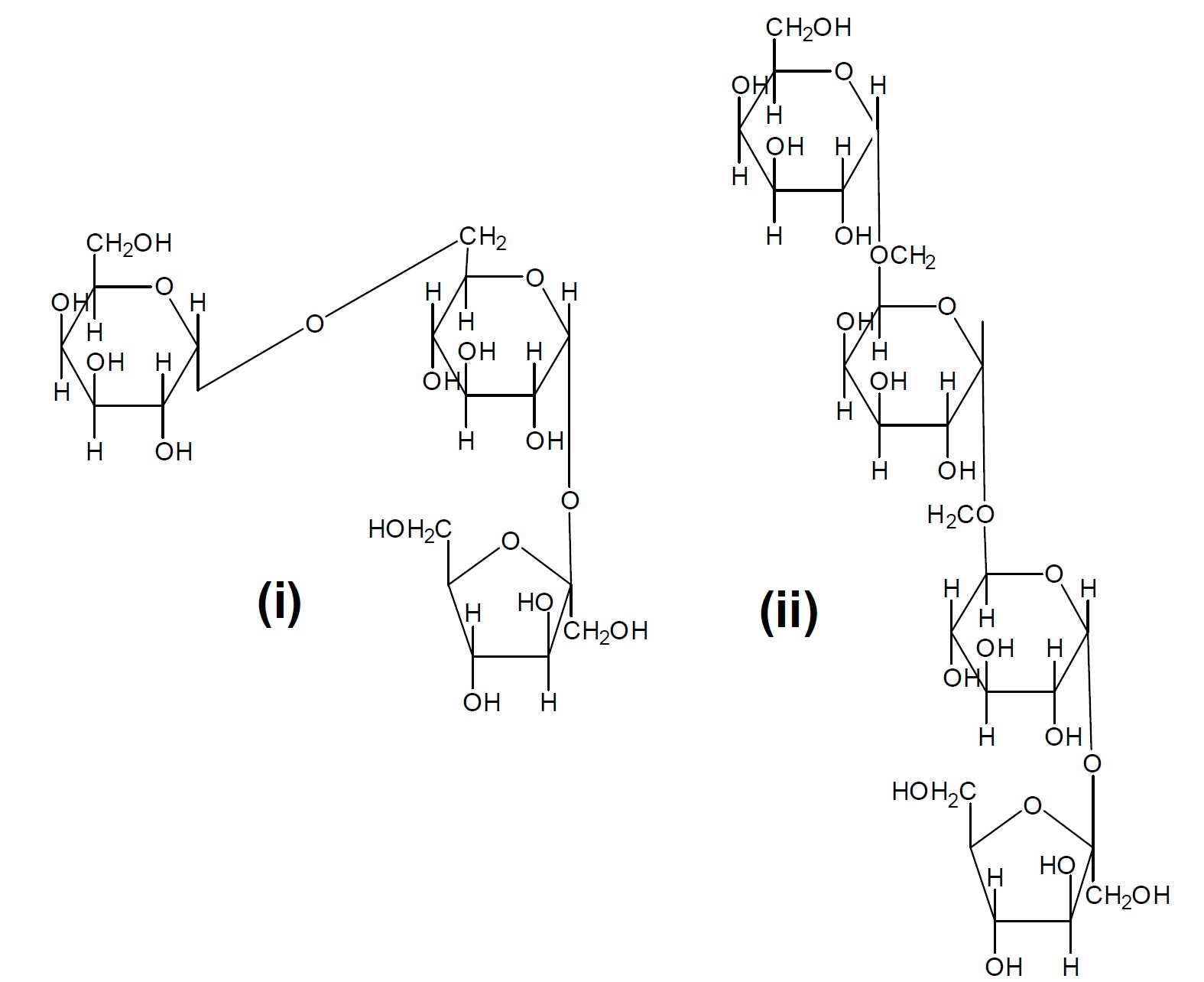Analysis of Oligosaccharides

Background
Carbohydrates can be classified into three groups:
1. Monosaccharides - a single sugar unit (e.g glucose, xylose, and fructose).
2. Oligosaccharides - up to ten monosaccharide residues joined together by glycosidic linkages.
3. Polysaccharides - generally considered to be polymers of more than ten monosaccharide residues. Examples include cellulose, hemicellulose, and starch.
Disaccharides are the smallest form of oligosaccharides and consist of two monosaccharide units. Sucrose ((iii) in the figure below), a disaccharide of glucose and fructose is the most important disaccharide in plants, occupying much of the mass balance in species such as sugarcane, sugar beets and sweet sorghum. Other important disaccharides include the dimers cellobiose and maltose ((i) and (ii) in the figure below, respectively). These are the repeating units of cellulose and starch, respectively, and can be obtained upon their partial hydrolysis.

There are numerous oligosaccharides that have more than two units. More than 500 oligosaccharides with betwen three and ten sugar units are known, many of which occur as free natural substances. Due to their low chain length, oligosaccharides are often soluble in water and can be removed from biomass during extractives analysis. Oligosaccharides commonly found in the vegetative parts of grasses and some barks include raffinose (a trisaccharide containing galactose, glucose, and fructose) and stachyose (a tetrasaccharide which consists of two galactose units, glucose, and fructose). These are illustrated in the figure below ((i) - raffinose, (ii) - stachyose).

Oligosaccharides in Pre-treatment and Hydrolysis Liquids
Hydrolysis biorefining technologies aim to produce biofuels and/or platform chemicals from the polysaccharides of lignocellulosic biomass by breaking them apart into their constituent monosaccharide (single sugar) units. This can be done in various ways, including using enzymes and chemicals. Furthermore, these technologies often involve a pre-treatment stage to make the lignocellulosic matrix more amenable to subsequent hydrolysis and in many cases these pre-treatments can partially hydrolyse some of the polysaccharides.
This partial hydrolysis can result in a significant proportion of the hemicellulosic and/or cellulosic sugars being tied up in soluble oligosaccharides that are contained within the process liquor. It is important to know whether the soluble sugars are present in monosaccharide or oligomer forms as these will affect subsequent downstream processing steps and the effective valorisation of the liquid component.
Oligosaccharides in Bio-Oil
Similarly, the water extract of the bio-oil fraction produced in pyrolysis may contain oligosaccharides in addition to the monosaccharides and anhydrosugars. Please click here to read more about bio-oil and the analysis methods that we use to characterise it.
Analysis of Oligosaccharides at Celignis
Direct Analysis of Oligosaccharides
We can characterise some oligosaccharides directly using our ion chromatography system. These include sucrose, cellobiose, raffinose, and melibiose. These can be analysed in the water extracts of biomass samples (obtained from analysis packages P5 - Water Extractives, P6 - Full Extractives, and P10 - Sugars, Lignin, Extractives, Ash) using analysis package P12 - Sugars in Solvent Extract, or in general process liquids using analysis package P21 - Sugars in Solution. These packages are detailed below:
P12 Sugars in Solvent Extract |
|---|
| Glucose, Xylose, Fructose, Sucrose, Mannose, Arabinose, Galactose, Rhamnose, Xylitol, Sorbitol, Trehalose, Mannitol, Arabinitol, Glycerol, Raffinose |
P21 Sugars in Solution |
|---|
| Total Sugars, Glucose, Xylose, Mannose, Arabinose, Galactose, Rhamnose, Xylitol, Sucrose, Fructose, Sorbitol, Trehalose, Mannitol |
If you would like us to directly determine other oligosaccharides then this may be possible depending on whether a suitable chromatography method for separation and appropriate chemical standards for those oligosaccharides are available. Please get in touch with us to discuss this.
Determination of the Proportions of Each Sugar in the Oligomeric Form
Analysis package P13 - Sugars and Oligosaccharides in Solution can be used to determine the total oligomeric sugar content of a liquid and also the relative proportions that each monosaccharide contributes to this total amount. The package involves a number of stages of analysis.
Firstly, the liquid is analysed using our ion chromatography system for the free monosaccharides and disaccharides in solution, just as in package P21 - Sugars in Solution.
Then we subject the liquid to a mild form of acid hydrolysis involving 4% sulphuric acid and 1 hour in an autoclave at 121 degrees Celcius. These conditions will break apart any oligosaccharides into their constituent monosaccharide units.
The liquid is subsequently filtered and analysed again on our IC system, to determine the amounts of various monosaccharides, after correction for any losses in sugars associated with the hydrolysis process. For each monosaccharide there will now be two values, the concentration prior to hydrolysis and that after hydrolysis.
With the exception of fructose (which degrades to hydroxymethylfurfural during the autoclaving step) all monosaccharides should be present in greater concentration post-hydrolysis. Hence, the proportion of each sugar that is present in the original liquid in the oligomeric form can be calculated by subtracting the pre-hydrolysis concentration from the post-hydrolysis concentration. As we report the sucrose and cellobiose contents separately we correct the calculated oligomeric glucan content using those data.
The constituents determined in analysis package P13 - Sugars and Oligosaccharides in Solution are detailed below. In our reports for P13 we report the pre-hydrolysis, post-hydrolysis and oligomeric concentrations of each sugar.
P13 Sugars and Oligosaccharides in Solution |
|---|
| Total Oligomeric Sugars, Total Sugars, Glucose, Xylose, Mannose, Arabinose, Galactose, Rhamnose, Xylitol, Sucrose, Fructose, Sorbitol, Trehalose, Mannitol |
We have a similiar analysis package to P13 that is used for determining the oligomeric composition of the water extract of pyrolysis bio-oils. Analysis package P62 - Sugars and Oligosaccharides in Bio-oil Water Extract differs in that, rather than quantifying the sugar alcohols it instead determines the amounts of various anhydrosugars (such as levoglucosan, cellobiosan, mannosan, and galactosan) that are present in the original liquid.
As with P13, analysis package P62 then involves the acid hydrolysis of the liquid to calculate the oligomeric composition. However, in this case the anhydrosugars will be hydrolysed to their hydrated aldose equivalents (i.e. levogluocosan and cellobiosan to glucose, mannosan to mannose, and galactosan to galactose) and we consider this in our calculations to ensure that the proportions of each sugar that are reported as being present in oligomers actually are. Analysis package P62 is detailed below:





